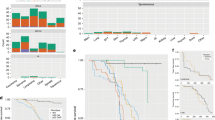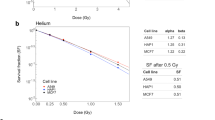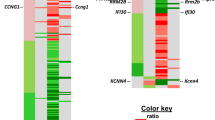Abstract
Genomic instability is effectively induced by ionizing radiation. Recently, evidence has accumulated supporting a relationship between genetic background and the radiation-induced genomic instability phenotype. This is possibly due to alterations in proteins responsible for maintenance of genomic integrity or altered oxidative metabolism. Studies in human cell lines, human primary cells, and mouse models have been performed predominantly using high linear energy transfer (LET) radiation, or high doses of low LET radiation. The interplay between genetics, radiation response, and genomic instability has not been fully determined at low doses of low LET radiation. However, recent studies using low doses of low LET radiation suggest that the relationship between genetic background and radiation-induced genomic instability may be more complicated than these same relationships at high LET or high doses of low LET radiation. The complexity of this relationship at low doses of low LET radiation suggests that more of the population may be at risk than previously recognized and may have implications for radiation risk assessment.
This is a preview of subscription content, access via your institution
Access options
Subscribe to this journal
Receive 50 print issues and online access
$259.00 per year
only $5.18 per issue
Buy this article
- Purchase on Springer Link
- Instant access to full article PDF
Prices may be subject to local taxes which are calculated during checkout



Similar content being viewed by others
References
Amundson S, Do K and Fornace Jr A . (1999). Radiat. Res., 152, 225–231.
An M and Kim T . (2002). J. Vet. Sci., 3, 213–218.
Ban N, Yoshida K, Aizawa S and Wada S . (2002). Radiat. Res., 158, 69–77.
Baria K, Warren C, Eden O, Roberts S, West C and Scott D . (2002). Int. J. Radiat. Biol., 78, 341–346.
Baverstock K, Sankaranarayanan K and Thorne M 2003, Unpublished Data.
Bouffler S, Meijne E, Huiskamp R and Cox R . (1996). Radiat. Res., 146, 349–352.
Boulton E, Cleary H, Papworth D and Plumb M . (2001). Int. J. Radiat. Biol., 77, 21–29.
Chang W, Hwang B, Wang D and Wang J . (1997). Lancet, 350, 330–333.
Chang W and Little J . (1992). Mutat. Res., 270, 191–199.
Clutton S, Townsend K, Walker C, Ansell J and Wright E . (1996). Carcinogenesis, 17, 1633–1639.
Committee on the Biological Effects of Ionizing Radiation. (1990). Effects of exposure to low levels of ionizing radiations National Academy of Sciences/National Research Council, Washington, DC.
Dent P, Yacoub A, Contessa J, Caron R, Amorino G, Valerie K, Hagan M, Grant S and Schmidt-Ullrich R . (2003). Radiat. Res., 159, 283–300.
Di Majo V, Coppola M, Rebessi S, Saran A, Pazzaglia S, Pariset L and Covelli V . (1996). Radiat. Res., 146, 81–87.
Goodhead D . (1988). Health Phys., 55, 231–240.
Gorgojo L and Little J . (1989). Int. J. Radiat. Biol., 55, 619–630.
Green L, Murray D, Tran D, Bant A, Kazarian G, Moyers M and Nelson G . (2001). Radiat. Res., 155, 32–42.
Grosovsky A, Parks K, Giver C and Nelson S . (1996). Mol. Cell. Biol., 16, 6252–6262.
Gudkov A and Komarova E . (2003). Nat. Rev. Cancer, 3, 117–129.
Harper K, Lorimore S and Wright E . (1997). Exp. Hematol., 25, 263–269.
Holmberg K, Falt S, Johansson A and Lambert B . (1993). Mutat. Res., 286, 321–330.
Honma M, Momose M, Tanabe H, Sakamoto H, Yu Y, Little J, Sofuni T and Hayashi M . (2000). Mol. Carcinogen., 28, 203–214.
Honma M, Zhang L, Hayashi M, Takeshita K, Nakagawa Y, Tanaka N and Sofuni T . (1997). Mol. Cell. Biol., 17, 4774–4781.
Kadhim M, Lorimore S, Hepburn M, Goodhead D, Buckle V and Wright E . (1994). Lancet, 344, 987–988.
Kadhim M, Lorimore S, Townsend K, Goodhead D, Buckle V and Wright E . (1995). Int. J. Radiat. Biol., 67, 287–293.
Kadhim M, Macdonald D, Goodhead D, Lorimore S, Marsden S and Wright E . (1992). Nature, 355, 738–740.
Kadhim M, Marsden S and Wright E . (1998). Int J. Radiat. Biol., 73, 143–148.
Kadhim M, Pocock D, Lorimore S and Wright E . (1999). Br. J. Haematol., 105, 673–675.
Kadhim M, Walker C, Plumb M and Wright E . (1996). Int. J. Radiat. Biol., 69, 167–174.
Kang C, Park K, Song J, Jeoung D, Cho C, Kim T, Bae S, Lee S and Lee Y . (2003). Radiat. Res., 159, 312–319.
Lavin M and Shiloh Y . (1999). Primary Immunodeficiency Diseases: A Molecular and Genetic Approach. Ohs HD, Smith CIE and Puck J (eds). Oxford University Press: Oxford, pp. 306–323.
Leger C and Drobetsky E . (2002). Carcinogenesis, 23, 1631–1639.
Limoli C, Corcoran J, Jordan R, Morgan W and Schwartz J . (2001). Br. J. Cancer, 84, 489–492.
Limoli C, Ponnaiya B, Corcoran J, Giedzinski E, Kaplan M, Hartmann A and Morgan W . (2000). Adv. Space Res., 25, 2107–2117.
Lindholm C, Makelainen I, Paile W, Koivistoinen A and Salomaa S . (1999). Int. J. Radiat. Biol., 75, 921–928.
Little J . (2000). Carcinogenesis, 21, 397–404.
Lorimore S, Goodhead D and Wright E . (1993). Int. J. Radiat. Biol., 63, 655–660.
Lorimore S and Wright E . (2003). Int. J. Radiat. Biol., 79, 15–25.
Major I . (1979). Br. J. Cancer, 40, 903–913.
Major I and Mole R . (1978). Nature, 272, 445–456.
Marder B and Morgan W . (1993). Mol. Cell. Biol., 13, 6667–6677.
McIlrath J, Lorimore S, Coates P and Wright E . (2003). Int. J. Radiat. Biol., 79, 27–34.
Morgan W . (2003). Radiat. Res., 159, 567–580.
Morgan W, Day J, Kaplan M, McGhee E and Limoli C . (1996). Radiat. Res., 146, 247–258.
Mothersill C, O'Malley K, Murphy D, Seymour C, Lorimore S and Wright E . (1999). Carcinogenesis, 20, 2273–2278.
Okayasu R, Suetomi K, Yu Y, Silver A, Bedford J, Cox R and Ullrich R . (2000). Cancer Res., 60, 4342–4345.
Pampfer S and Streffer C . (1989). Int. J. Radiat. Biol., 55, 85–92.
Papworth R, Slevin N, Roberts S and Scott D . (2001). Br. J. Cancer, 84, 776–782.
Plumb M, Cleary H and Wright E . (1998). Int. J. Radiat. Biol., 74, 711–720.
Ponnaiya B, Cornforth M and Ullrich R . (1997). Radiat. Res., 147, 121–125.
Rodgers B, Chesser R, Wickliffe J, Phillips C and Baker R . (2001). Environ. Toxicol. Chem., 20, 2830–2835.
Sabatier L, Dutrillaux B and Martin M . (1992). Nature, 357, 548.
Salomaa S, Holmberg K, Lindholm C, Mustonen R, Tekkel M, Veidebaum T and Lambert B . (1998). Int. J. Radiat. Biol., 74, 771–779.
Salomaa S, Lindholm C, Tankimanova M, Mamyrbaeva Z, Koivistoinen A, Hulten M, Mustonen R, Dubrova Y and Bersimbaev R . (2002). Radiat. Res., 158, 591–596.
Sankaranarayanan K . (2001). Health Phys., 80, 363–369.
Sankaranarayanan K and Chakraborty R . (2001). Radiat. Res., 156, 648–656.
Schwartz J, Jordan R, Liber H, Murnane J and Evans E . (2001). Genes Chromosomes Cancer, 30, 236–244.
Seymour C, Mothersill C and Alper T . (1986). Int. J. Radiat. Biol., 50, 167–179.
Smith L, Parks K, Hasegawa L, Eastmond D and Grosovsky A . (1998). Mutagenesis, 13, 435–443.
Smith L, Plug A and Thayer M . (2001). Proc. Natl. Acad. Sci. USA, 98, 13300–13305.
Ullrich R, Bowles N, Satterfield L and Davis C . (1996). Radiat. Res., 146, 353–355.
Vessey C, Norbury C and Hickson I . (1999). Prog. Nucleic Acids Res. Mol. Biol., 63, 189–221.
Watson G, Lorimore S, Clutton M, Kadhim M and Wright E . (1997). Int. J. Radiat. Biol., 71, 497–503.
Watson G, Pocock D, Papworth D, Lorimore S and Wright E . (2001). Int. J. Radiat. Biol., 77, 409–417.
Weil M, Kittrell F, Yu Y, McCarthy M, Zabriskie R and Ullrich R . (2001). Oncogene, 20, 4409–4411.
Yu Y, Okayasu R, Weil M, Silver A, McCarthy M, Zabriskie R, Long S, Cox R and Ullrich R . (2001). Cancer Res., 61, 1820–1824.
Acknowledgements
I am grateful to the following people: Stephen R Moore, Dudley T Goodhead, Edwin Goodwin, and Keith Baverstock for valuable contribution and comments; Denise Macdonald, Debbie Bowler, Gwyneth Watson (RAGSU, MRC, Harwell, UK) for assistance in experimental studies on radiation-induced chromosomal instability; Lora Green (Loma Linda University Medical Center, Loma Linda, CA, USA) for analysis of apoptosis; and David Papworth (RAGSU, MRC, Harwell, UK) for statistical analysis. This work was supported by the Medical Research Council (UK) and the National Aeronautics and Space Administration (NASA, USA).
Author information
Authors and Affiliations
Corresponding author
Rights and permissions
About this article
Cite this article
Kadhim, M. Role of genetic background in induced instability. Oncogene 22, 6994–6999 (2003). https://doi.org/10.1038/sj.onc.1206883
Published:
Issue Date:
DOI: https://doi.org/10.1038/sj.onc.1206883
Keywords
This article is cited by
-
Transgenerational accumulation of radiation damage in small mammals chronically exposed to Chernobyl fallout
Radiation and Environmental Biophysics (2006)



